




Resonant Transmutation of Phosphorus by Bacteria
Biomimetic Stone and Bacterial Transmutations of Bone Phosphorus
by Alex Putney for Human-Resonance.org
February 7, 2013
The Vedruss Elders of the Siberian taiga have preserved a wealth of knowledge concerning invisible energies and our conscious relationship with the living world. Wisewoman Anastasia has given detailed descriptions of an enhanced communication with the biological world as engendered by ancient Vedic practices involving the DNA imprinting of seeds within a sacred family garden, and the holistic benefits of maintaining biorhythmic resonance with plants through barefoot contact with the living Earth.
Anastasia explains that children raised in sacred family gardens will gain natural telepathic influence over microbial life forms, citing young siblings named Kostia and Dashenka. Kostia explains to his bewildered father: "Dasha's... made friends with microbes. They obey her... the ones that are very prolific, that live everywhere, all around us and inside us. We can't see them, but they're there." Dashenka continues [V Megre (2005) "Who Are We?" Ringing Cedars Press, pp. 72-73]:
"I call them my 'little ones', my 'goodies'... I play with them sometimes. People pay hardly any attention to them, but they always try to do good for everyone. When Man is joyful --they feel good too from the joyful energy; when Man is angry and hurts something living --a lot of them perish. Others rush in to replace them. But sometimes the others don't manage to replace the ones that have died --and Man's body becomes ill."
The crucial importance of balanced gut flora and the human immune system is now well understood, confirming the Ayurvedic knowledge possessed by these children, pointing out the potential for direct microbial mitigation of airborne radioactive dust metals from the Chernobyll and Fukushima disasters. Ingestion of 5g/day of the beneficial cyanobacterium spirulina reverses radioactive toxicity in 5 weeks, while the bacterial cleanup of airborne radioactive dust metals is constantly and invisibly taking place.
Nature's rapid cleanup of the bones of dead animals in normal soil conditions occurs by similar microbial processes that have been applied in the relative dating of ancient bones based on the measurement of fluorine gas content in a process that is not entirely understood. In fact, the source of fluorine atoms perpetually accumulating during bone decomposition has not been clearly identified, until now.
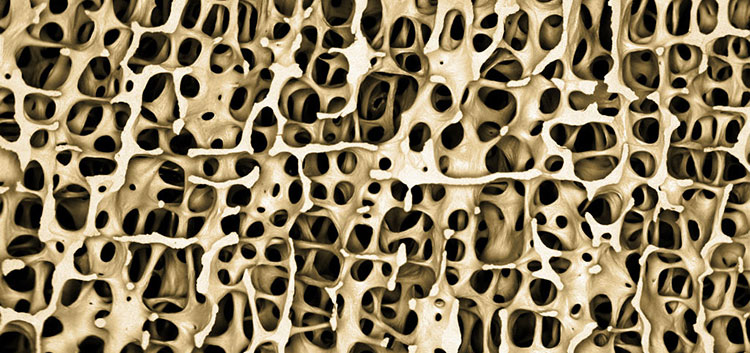
The first scientific investigations of bone decay were undertaken over 150 years ago, firmly establishing the significant accumulation of fluorine gas within spongy bone samples over time. Researchers suggested a link between bone fluorine content and localized fluoride levels in groundwater leaching through soils (Middleton, 1844; Rivičre & Carnot, 1895). While this erroneous hypothesis formed the entire basis for the fluorine bone dating technique, the large surface area increase in spongy bone (above) does not increase fluoride uptake as supposed, but instead allows the proliferation of bacterial colonies that emit fluorine gas.
This early misattribution is quite understandable considering the essential role of biological transmutation in such processes was not addressed until the work of C.L. Kervran in the 1960's. Kervran identified the fluorine gas accumulation in bone as a byproduct of resonant nuclear transmutations occurring within living bacteria. This idea could not be proven in experiment at the time, but subsequent discoveries have partly described the digestive metabolic reactions taking place in bacterial colonies, as well as the exact temperature-dependent conditions that facilitate the sustained metabolic activity of bacterial species.
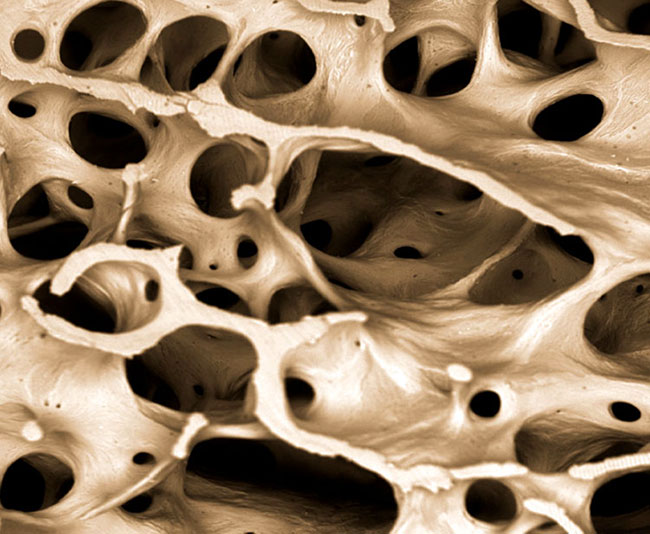
The gradual metabolic process of bone digestion by bacteria was carefully studied during periods of upto 15 years of shallow burial in soil, revealing the partial disappearance of collagen fibers and biomineral hydroxyapatite crystals. A species of bacterium named for its role in body tissue dissolution, Chlostridium bistolyticum is commonly found in soils and the animal and human gut, and has been identified as the primary cause of the notable destruction of microstructure in archeological bone (Jackes et al., 2001):
We believe we have shown that these Mesolithic bones are partly comprised of bacterially reprecipitated mineral, which has had collagen removed, with subsequent obliteration of bone microstructure... A Japanese experiment involving the burial of human bone for periods upto 15 years (Yoshino et al, 1991) proved that focal destruction is the result of bacterial action. These researchers did not characterize changes to the bone caused by bacterial action, but investigation of the morphology of Portugese Mesolithic bone led to the discovery of bacteria (Palmer, 1987) which encouraged us to concentrate on this question.
These bacteria... could not be isolated from bone scrapings (after freezing it was not possible to rehydrate the bacteria despite use of cryoprotectant), so identification was tentative. The bacteria appear to be Clostridium, 0.5-0.8µ long, with peritrichous flagellae, whip-like extensions all over the cell surface. Clostridium is an anaerobic bacterium, occurring in soil and in the intestines of humans and other animals... The best known bacteria which attack bone are Clostridium bistolyticum (the species name means 'tissue dissolving'). C. bistolyticum produces collagenase, the enzyme capable of digesting bone... [and is characterized as] motile and peritrichous straight rods..., occurring singly and side-by-side, in pairs or in short chains, and producing oval spores that cause the cell to bulge.
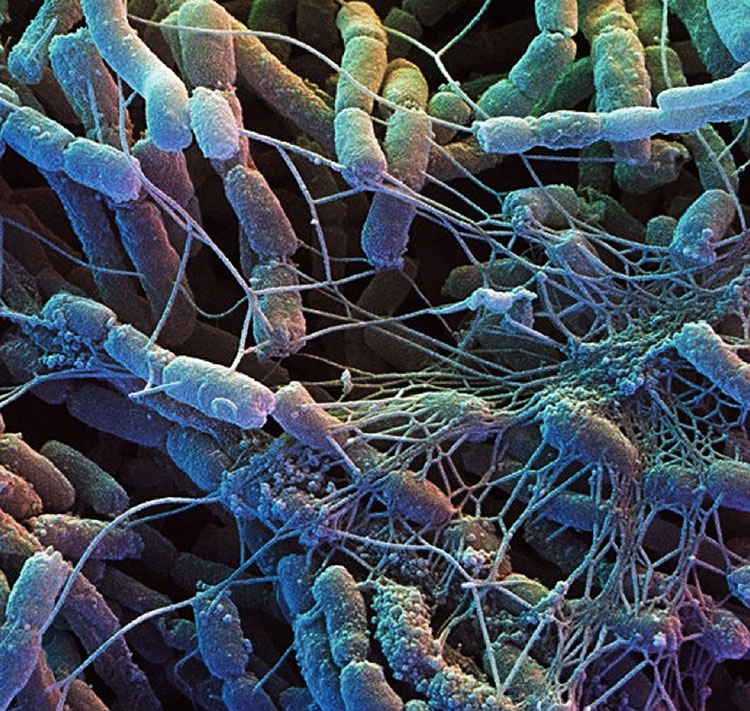
Bacterial secretion of collagenase enzyme dissolves collagen fibers for ingestion, while further exposing biomineral hydroxyapatite crystals, Ca5(PO4)3OH, as a rich source of calcium and phosphorus. Partial destruction of bone microstructures is inevitable as the matrix is bacterially decomposed, eventually becoming reduced to fine depositions of carbon dust excreted by the microbes (above). Fluorine gas is released during the temperature-induced low energy fission of phosphorus into fluorine and carbon:

The metabolic bacterial release of fluorine gas from this resonant nuclear reaction accounts for the measurable variation in gas concentration from bone samples of various ages, due to the increase of bacterial concentration with available bone surface area, reflecting heterogeneous colony distribution. These findings firmly establish the nuclear fission origin of fluorine gas from bone phosphorus, enabling refinement of the fluorine gas dating method as presently applied to archaeological investigation.
Rectification of the false working hypothesis that fluoride leaching from ground water sources causes fluorine build-up in bone demands a thorough reevaluation of the applicability of the method to various soil types and bone samples. Identification of this resonant fission reaction also reveals the specific temperature range requirement for enhanced microbial proliferation, redefining the crucial patterns of diurnal temperature fluctuation enabling bacterial conversion of phosphorus into carbon.
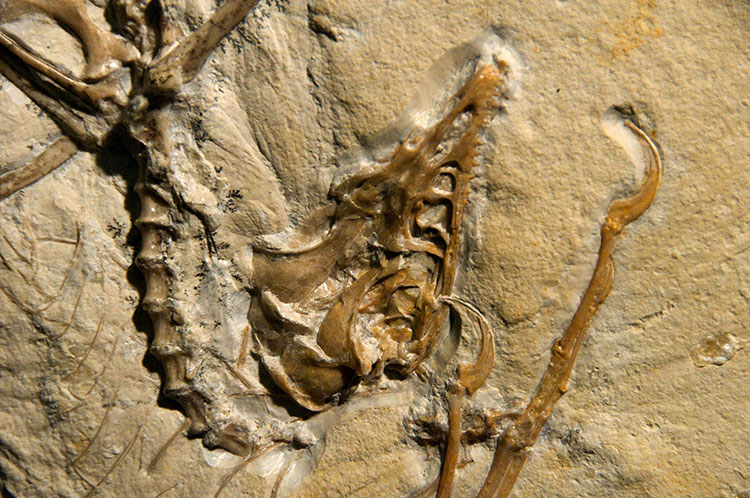
The resonant frequency of stable fluorine (F19) in its rest state is 3,774,148 Hz, according to the element's atomic diameter at 20°C. Nitrogen isotope (N14 absorbed within the phosphorus lattice) resonates at this same frequency when heated to 24.7°C:
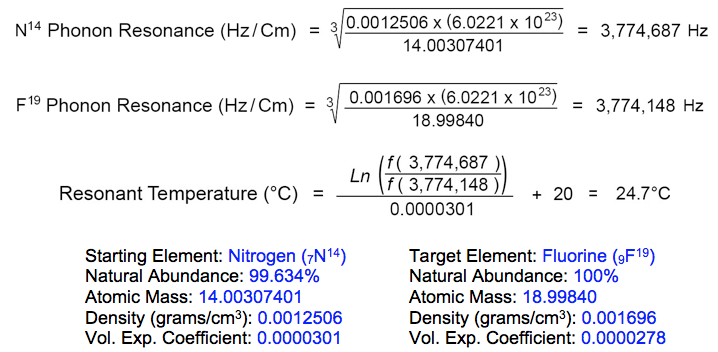
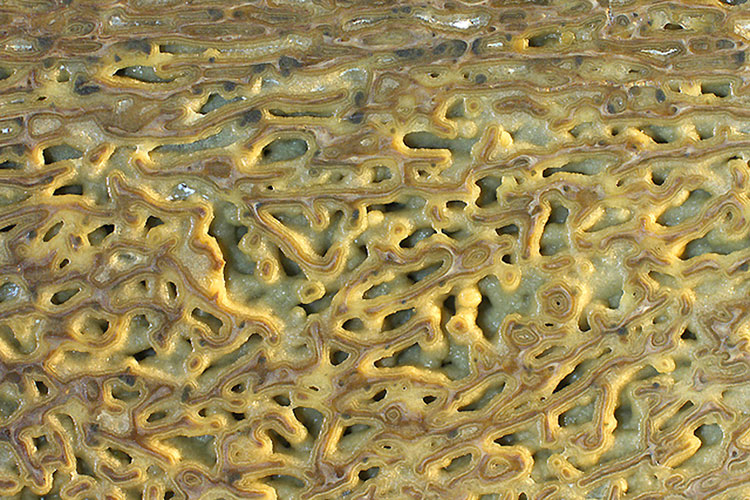
Dimensional phonon resonance interactions of the elements provide the basis for a new understanding of essential biological processes that have eluded all prior identification despite decades of painstaking inquiry. Bacterial dissolution of bone matrix by enzymatic liquification reverses the complex process of bone formation, which has been effectively replicated in vitro, using a liquid-phase mineral precursor to hydroxyapatite. This breakthrough in biomaterials research applies a new model to comprehensively explain how intrafibrillar mineralization of collagen occurs during bone formation (Olszta et al., 2007):
Secondary (osteonal) bone, the focus of this review, is a laminated organic inorganic composite composed primarily of collagen, hydroxyapatite, and water; but minor constituents, such as non-collagenous proteins (NCPs), are also present and are thought to play an important role in bone formation...
In the case of bone biomineral, we have now been able to duplicate the most fundamental level of bone structure, the interpenetrating nanostructured architecture, using relatively simple anionic polypeptides that mimic the polyanionic character of the NCPs. We propose that the charged polymer acts as a process-directing agent, by which the conventional solution crystallization is converted into a precursor process. This polymer-induced liquid-precursor (PILP) process generates an amorphous liquid-phase mineral precursor to hydroxyapatite which facilitates intrafibrillar mineralization of type-I collagen because the fluidic character of the amorphous precursor phase enables it to be drawn into the nanoscopic gaps and grooves of collagen fibrils by capillary action. The precursor then solidifies and crystallizes upon loss of hydration waters into the more thermodynamically stable phase, leaving the collagen fibrils embedded with nanoscopic hydroxyapatite crystals.
Electron diffraction patterns of the highly mineralized collagen fibrils are nearly identical to those of natural bone, indicating that the hydroxyapatite crystallites are preferentially aligned with orientation along the collagen fibril axes. In addition, studies of etched samples of natural bone and our mineralized collagen suggest that... collagen is the primary template for crystal organization, but with the important caveat that this templating occurs only for crystals formed from an infiltrated amorphous precursor...
From a biomedical perspective, in addition to providing possible insight into the role of NCPs in bone formation, this in vitro system may pave the way toward the ultimate goal of fabricating a synthetic bone substitute that not only has a composition similar to bone, but has comparable mechanical properties and bioresorptive potential as natural bone. From a materials chemistry perspective, the non-specificity of the PILP process and capillary infiltration mechanism suggests that non-biological materials could also be fabricated into nanostructured composites using this "biomimetic" strategy.
In vitro replication of the biomineral crystallization process of bone formation closely reproduces the fine crystallographic structures observed of biological bone samples, suggesting that non-collagenous proteins dictate the alignment of seed nanocrystals. Images of the morphology of artificial porous hydroxyapatite ceramic samples were obtained by scanning electron microscopy (Rusnah, 2011), presenting foam-like structures left by gas bubble clusters present within the liquid during crystallization (below).
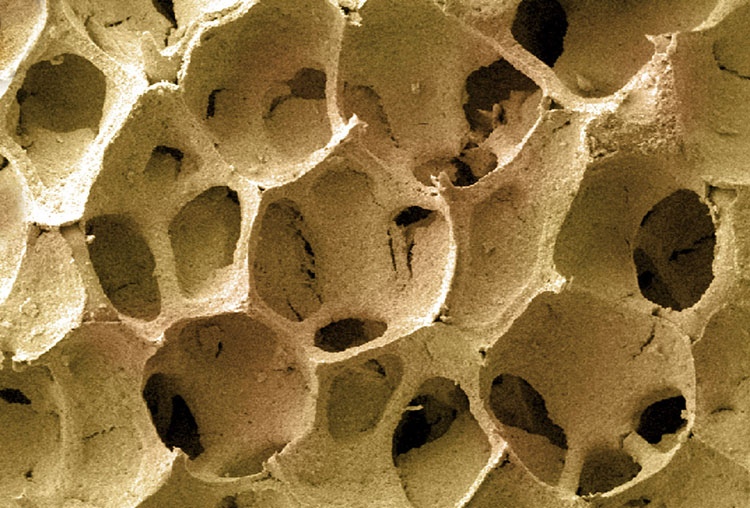
Artificial hydroxyapatite produced in modern laboratory experiments has lead to the application of novel calcium-phosphate bone cements (Combes et al., 2007) and also confirms the extraordinary findings of geopolymer experts regarding the artificial origin of the stones of Egypt's Orion pyramids. The high content of calcite, opal CT and hydroxyapatite crystals constituting the Great Pyramid's artificial limestones (Davidovits, 1984) attests to an ancient global Vedic biotechnology of psychoacoustic architecture, constructed in high-resonance biomimetic geopolymer stone (below).
The octahedral form of each of the pyramids references the calcite biomineralizations of the human pineal gland, known as the ajna or 'third-eye' chakra in ancient Sanskrit tradition, while the complex composition of the pyramids' cement blocks mimic the resonant characteristics of human bone. The presence of gas bubbles within artificial limestones --having been poured as liquid cement-- significantly lowers the density of these ancient geopolymer products. Hydroxyapatite crystals within the stones may substitute calcium with various bivalent metal ions, as observed in natural bone (Gutowska et al., 2005).
The resonant properties of the crystalline formations of human bone have been incorporated into every stone of ancient Vedic temples to enhance acoustic energy storing within the buildings. Similarly, sacred Ayurvedic waters contain trace amounts of electroluminescent gold and silver nanoparticles to enhance the resonant capacity of the human body, generating red and blue light by surface plasmon resonance during barefoot exposure to piezoelectric temples, linking bone with stone for bioelectrical healing.
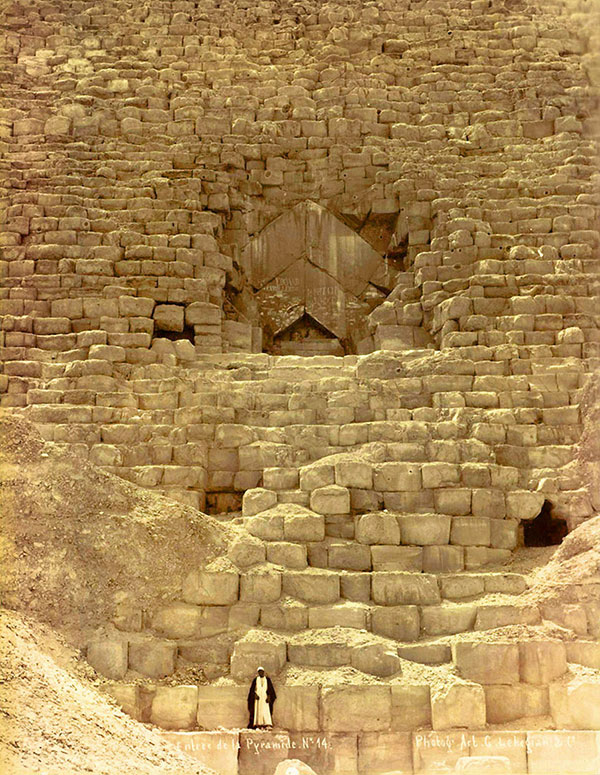
Copyright 2013-2015 Alexander Putney